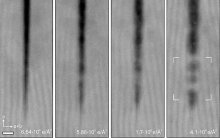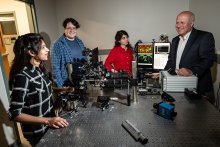News

$2.9 million to track snowfall in a warming world
Posted
Associate professor Ardeshir Ebtehaj received $2.9 million from NASA to provide a satellite record of global snowfall. The project will provide new opportunities to explore the cryosphere and how it impacts water resources.

CSE Ph.D. student awarded 2023 Outstanding Community Service Award
Posted
CSE Graduate Research Fellow Maddy Nyblade was awarded the University of Minnesota Outstanding Community Service Award. Nyblade is collaborating with Minnesota indigenous tribes to study the climate and land use impacts on Manoomin, better known as wild rice.

UMN College of Science and Engineering welcomes largest undergraduate class in history
Posted
Recently released enrollment numbers show that the University of Minnesota College of Science and Engineering (CSE) welcomed the largest incoming first-year class in history in fall 2023, as it heads for undergraduate growth of 20 percent by 2028 to meet increasing workforce needs.

U of M celebrates selection of Minnesota MedTech 3.0 as federal Tech Hub
Posted
The Minneapolis Saint Paul Economic Development Partnership has been selected by the U.S. Department of Commerce as one of its inaugural Tech Hubs. The University of Minnesota College of Science and Engineering partnered in the formulation and execution of the MedTech 3.0 concept.

Surprising discovery shows electron beam radiation can repair nanostructures
Posted
In a surprising new study, researchers at the University of Minnesota Twin Cities have found that the electron beam radiation that they previously thought degraded crystals can actually repair cracks in these nanostructures.

Construction begins on new $144.7 million Chemistry Teaching Laboratories
Posted
The University of Minnesota began construction on a new $144.7 million state-funded Chemistry Undergraduate Teaching Laboratories.

CSE welcomes 25 new faculty in 2023-24
Posted
A new group of educators and researchers are bringing their expertise—from reinforced concrete to cutting-edge AI technologies—to the Twin Cities campus this 2023-24 academic year.

University of Minnesota receives $16M to uncover 'wiring diagram' of the brain
Posted
University of Minnesota College of Science and Engineering Professor Taner Akkin is part of a research team that has received a $16 million grant from the National Institutes of Health (NIH) to support the groundbreaking project of unraveling the mysteries of the brain's ‘wiring diagram.’

University of Minnesota receives $53.9 million to advance health research
Posted
Two University of Minnesota engineering professors are part of the leadership team that will administer a $53.9 million grant from the National Institutes of Health to find better, faster ways to bring scientific advances to real-world use.

CSE Dean Andrew Alleyne appointed to Department of the Navy Science and Technology Board
Posted
University of Minnesota College of Science and Engineering Dean Andrew Alleyne has been appointed as an inaugural member to the United States Department of the Navy Science and Technology Board (DoN S&T Board).
